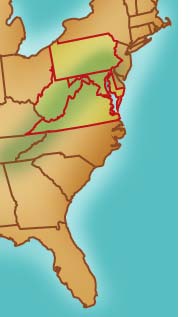IPM and Conservation Programs: Enabling Appalachian apple growers to achieve greater access to Farm Bill program support in the adoption of environmentally sound pest management and resource conservation practices
 In the broad, rolling hills of orchard country in Virginia, West Virginia, Pennsylvania, and Maryland, fruit production continues to be an important agricultural activity. Apples are the most widely produced fruit crop in the region, covering more than 57,000 acres, according to the 2002 Census of Agriculture, though acreage in 2005 was somewhat lower. Many of those orchards are diversified operations that include other tree fruit, (e.g., peaches, pears, cherries), small fruit (strawberries, blueberries and a growing number of vineyards), and some vegetables. While apples are widely grown in those states, two-thirds of the acreage is in a dozen counties that stretch from the Northern Shenandoah Valley, through the panhandle of West Virginia into south central Pennsylvania and the northern counties of Maryland. Orchards in the region share a similar topography and landscape with many resource considerations in common. Apple production throughout the region, as is the case for other fruit crops, requires intensive pest management to produce a marketable crop. Apple growers must contend with more than two dozen insect pests and more than a dozen diseases that infest the fruit and damage the trees.
In the broad, rolling hills of orchard country in Virginia, West Virginia, Pennsylvania, and Maryland, fruit production continues to be an important agricultural activity. Apples are the most widely produced fruit crop in the region, covering more than 57,000 acres, according to the 2002 Census of Agriculture, though acreage in 2005 was somewhat lower. Many of those orchards are diversified operations that include other tree fruit, (e.g., peaches, pears, cherries), small fruit (strawberries, blueberries and a growing number of vineyards), and some vegetables. While apples are widely grown in those states, two-thirds of the acreage is in a dozen counties that stretch from the Northern Shenandoah Valley, through the panhandle of West Virginia into south central Pennsylvania and the northern counties of Maryland. Orchards in the region share a similar topography and landscape with many resource considerations in common. Apple production throughout the region, as is the case for other fruit crops, requires intensive pest management to produce a marketable crop. Apple growers must contend with more than two dozen insect pests and more than a dozen diseases that infest the fruit and damage the trees.
Experience since 2002 has shown that creating meaningful access to financial and technical assistance for specialty crop growers requires increased awareness and understanding among growers of program opportunities and conservation fundamentals, access to planning and technical assistance, education in the effective use of conservation practices, and the development of program policies and financial assistance opportunities appropriate to the unique production and conservation needs of, in this case, apple growers and their fruit-growing operations. This project will meet those needs by achieving the following objectives:

- Objective 1) Enable growers to gain the understanding necessary to use federal conservation programs in the adoption of environmentally sound pest management and resource conservation practices through targeted educational efforts.
- Objective 2) Enable apple growers to effectively participate in EQIP to support IPM through the creation of appropriate programmatic opportunities for financial assistance and development of a pilot training program for technical assistance.
- Objective 3) Increase awareness and interest in the adaptation of EQIP to IPM and fruit production among growers, University staff, NRCS staff, conservationists and policy makers through the documentation and dissemination of project efforts and results.
By creating greater knowledge, access and opportunities for apple growers to use conservation programs this project will improve pesticide risk reduction and resource conservation in the Appalachian fruit growing region and to create a knowledge base so that these efforts can be replicated for other specialty crops and regions.
The advantage of working across the region has been to take innovations developed in one state and applying them to increasing opportunities in the other states. Pennsylvania was the first state to establish orchard IPM incentives through federal conservation programs due to the leadership of growers in Adams County and Penn State University research and Extension staff. Their work has been well-documented (paipm.cas.psu.edu/65.htm) and applied to designing a similar program opportunity for apple growers in Maryland.
This past year West Virginia, through the efforts of West Virginia University staff and Virginia through the efforts of Virginia Tech and Cooperative Extension staff have also succeeded in working with their respective state NRCS offices to establish incentives for tree fruit IPM.
Although the programs in each state are somewhat different they rely on a shared foundation of production science. As a result, a common training program has been developed and is being used this year for practitioners of IPM through EQIP. This collaboration is shortening the learning curve for incorporating IPM into EQIP and increasing the opportunities for growers to participate.
Putting the Farm Bill to Work Quick Links
- Appalachian Region
- California
- Georgia
- Michigan
- North Carolina
- North Carolina Apple Growers
- North Carolina Nursery Crops
- North Carolina Christmas Trees
- North Carolina Strawberry Growers
- North Carolina Strawberry Survey
- North Carolina Sweetpotato Producers
- North Carolina Sweetpotato Survey Summary
- Western North Carolina Vegetable Growers
- Oregon

